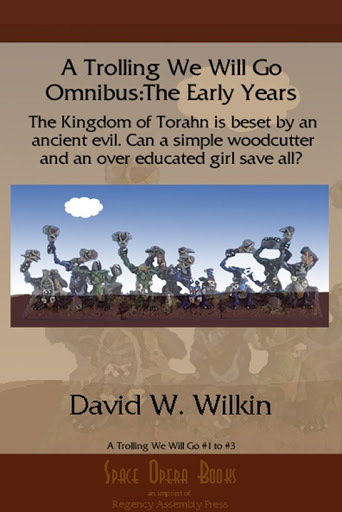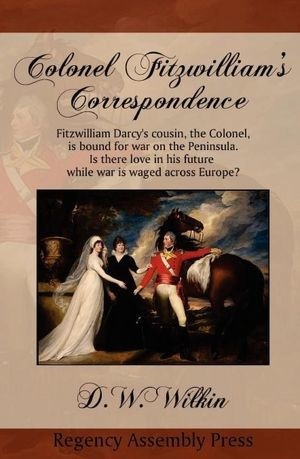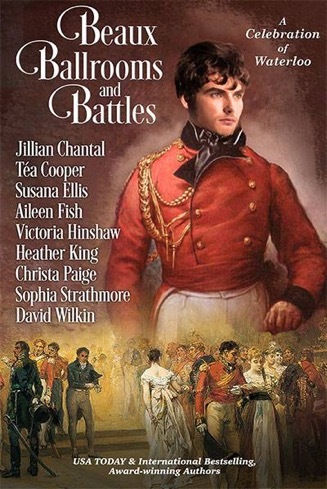D.W. Wilkin's Blog, page 5
January 1, 2017
A Trolling we Will Go Omnibus: The first three Fantasy stories of Humphrey and Gwendolyn
A Trolling We Will Go Omnibus:The Early Years
Not only do I write Regency and Romance, but I also have delved into Fantasy.
The Trolling series, (the first three are in print) is the story of a man, Humphrey. We meet him as he has left youth and become a man with a man’s responsibilities.
We follow him in a series of stories that encompass the stages of life. We see him when he starts his family, when he has older sons and the father son dynamic is tested.
We see him when his children begin to marry and have children, and at the end of his life when those he has loved, and those who were his friends proceed him over the threshold into death.
All this while he serves a kingdom troubled by monsters. Troubles that he and his friends will learn to deal with and rectify.
Here are the first three books together as one longer novel.
A Trolling We Will Go, Trolling Down to Old Mah Wee and Trolling’s Pass and Present.
Available in a variety of formats.
For $6.99 you can get this fantasy adventure.
Barnes and Noble for your Nook
The stories of Humphrey and Gwendolyn. Published separately in: A Trolling we Will Go, Trolling Down to Old Mah Wee and Trollings Pass and Present.
These are the tales of how a simple Woodcutter and an overly educated girl help save the kingdom without a king from an ancient evil. Long forgotten is the way to fight the Trolls.
Beasts that breed faster than rabbits it seems, and when they decide to migrate to the lands of humans, their seeming invulnerability spell doom for all in the kingdom of Torahn. Not only Torahn but all the human kingdoms that border the great mountains that divide the continent.
Feedback
If you have any commentary, thoughts, ideas about the book (especially if you buy it, read it and like it
December 31, 2016
Regency Personalities Series-Lady Ellenor Fenn
Regency Personalities Series
In my attempts to provide us with the details of the Regency (I include those who were born before 1811 and who died after 1795), today I continue with one of the many period notables.
Lady Ellenor Fenn
12 March 1743 – 1 November 1813
Ellenor Fenn was born in Westhorpe, Suffolk to Sheppard and Susanna Frere. John Frere was her elder brother and John Hookham Frere her nephew. In 1766 she married the antiquarian John Fenn and moved with him to Hill House, Dereham, Norfolk. Although they had no biological children, they adopted and brought up an orphaned heiress, Miss Andrews.
Fenn wrote a series of children’s books for her nephews and nieces, inspired by Anna Laetitia Barbauld’s Lessons for Children (1778-9), and in 1782 she wrote to the children’s publisher John Marshall asking whether he would be willing to publish them. Between 1782 and 1812, he published numerous books by Fenn, often anonymously or under the pseudonyms Mrs. Teachwell or Mrs. Lovechild. Cobwebs to Catch Flies (1783), a reading primer, was perhaps her most popular book; it went through multiple editions in both Britain and America until the 1870s. Her Child’s Grammar went through sixty editions by the 1860s.
Fenn also created toys and games that encouraged mothers to teach their children themselves. Andrea Immel, a specialist in 18th-century childhood, writes that through her games, we can “recognize [Fenn] as an early advocate of child-centered teaching strategies” The games emphasize conversation and the child’s own world; they encourage the mother to answer the child’s questions and to spontaneously teach when the child is interested in learning.
In 1795, Fenn had a falling out with her publisher, John Marshall, and moved her business to Elizabeth Newbery’s firm and publishers in Norwich. Throughout her career, Fenn never received any royalties for her work, only free distribution copies of her works.
When Fenn’s husband was knighted in 1787, Fenn became known as Lady Fenn. He served as High Sheriff of Norfolk from 1791-2. Upon his death on 14 February 1794, Fenn was left “financially secure” and able to devote more of her time to philanthropy. Fenn established a Sunday School in Dereham in 1785 which by 1788 had over 100 pupils. She also started a needlework school and “revived the trade to tow-spinning to give poor women an income.”
Fenn died at Dereham on 1 November 1813, aged 69, and was buried at St Bartholomew’s church, Finningham, Suffolk.
On 29 November 2013, two hundred years after her death, Fenn was finally recognised in Dereham with the unveiling of a ‘Blue Plaque’ outside Hill House, her home for nearly fifty years, beside a renewed plaque for her husband.
Many of Fenn’s works were directed towards young girls and women. She wrote an entire series entitled “Mrs. Teachwell’s Library for Young Ladies.” Many of these works focus on how to teach and outline Fenn’s idea of proper reading materials.
Fenn published several volumes of what we would now call picturebooks that employed woodcuts. Her sense of the visual layout of her books was keen and she carefully dictated to her publishers the margins and font sizes of her books.
This list of works relies almost exclusively on Carol Percy’s bibliography of Fenn’s works.
Set of Toys (c.1780) – game
School Occurrences (1782-3)
Juvenile Correspondence (1783)
Cobwebs to Catch Flies (1783)
Fables, by Mrs. Teachwell (1783)
Fables in Monosyllables by Mrs. Teachwell (1783)
Rational Sports (1783)
School Dialogues for Boys (1783-4)
Female Guardian (1784)
Art of Teaching in Sport (1785)
The Rational Dame (1786)
A Spelling Book (1787)
Fairy Spectator (1789)
Juvenile Tatler (1789)
The Village Matron (1795)
The Short History of Insects (1796); as the long title shows, this work was produced in association with the Leverian Museum.
The Infant’s Friend (1797)
The Mother’s Grammar (1798)
The Child’s Grammar (1798)
Parsing Lessons for Elder Pupils (1798)
Parsing Lessons for Young Children (1798)
The Friend to Mothers (1799)
Family Miscellany (1805)
The Teacher’s Assistant (1809)


A Jane Austen Sequel: Colonel Fitzwilliam’s Correspondence
Colonel Fitzwilliam’s Correspondence For your enjoyment, one of the Regency Romances I published.
It is available for sale and I hope that you will take the opportunity to order your copy.
For yourself or as a gift. It is now available in a variety of formats.
For just a few dollars this Regency Romance can be yours for your eReaders or physically in Trade Paperback.
Visit the dedicated Website
Barnes and Noble for your Nook or in Paperback
Amazon for your Kindle or in Trade Paperback
Witnessing his cousin marry for love and not money, as he felt destined to do, Colonel Fitzwilliam refused to himself to be jealous. He did not expect his acquaintance with the Bennet Clan to change that.
Catherine Bennet, often called Kitty, had not given a great deal of thought to how her life might change with her sisters Elizabeth and Jane becoming wed to rich and connected men. Certainly meeting Darcy’s handsome cousin, a Colonel, did not affect her.
But one had to admit that the connections of the Bingleys and Darcys were quite advantageous. All sorts of men desired introductions now that she had such wealthy new brothers.
Kitty knew that Lydia may have thought herself fortunate when she had married Wickham, the first Bennet daughter to wed. Kitty, though, knew that true fortune had come to her. She just wasn’t sure how best to apply herself.
Feedback
If you have any commentary, thoughts, ideas about the book (especially if you buy it, read it and like it
December 30, 2016
Regency Personalities Series-The Morning Post
Regency Personalities Series
In my attempts to provide us with the details of the Regency (I include those who were born before 1811 and who died after 1795), today I continue with one of the many period notables.
The Morning Post
1772 – 1937
The Morning Post was founded by John Bell. Originally a Whig paper, it was purchased by Daniel Stuart in 1795, who made it into a moderate Tory organ. A number of well-known writers contributed, including Samuel Taylor Coleridge, Charles Lamb, James Mackintosh, Robert Southey, and William Wordsworth. In the seven years of Stuart’s proprietorship, the paper’s circulation rose from 350 to over 4,000.
From 1803 until his death in 1833, the owner and editor of the Post was Nicholas Byrne; his son William Pitt Byrne later held these roles.
Later the paper was acquired by a Lancashire papermaker named Crompton. In 1848 he hired Peter Borthwick, a Scot who had been a Conservative MP for Evesham 1835-1847, as editor.
The paper was noted for its attentions to the activities of the powerful and wealthy, its interest in foreign affairs, and in literary and artistic events.


Beaux, Ballrooms, and Battles
A new Regency Anthology
Beaux, Ballrooms, and Battles anthology, celebrating the 200th anniversary of the victory at Waterloo in story.
Looks good, huh? The talented writer and digital artist, Aileen Fish created this.
It will be available digitally for $.99 and then after a short period of time sell for the regular price of $4.99
The Trade Paperback version will sell for $12.99
Click on the Amazon Link—>Amazon US

My story in the anthology is entitled: Not a Close Run Thing at All, which of course is a play on the famous misquote attributed to Arthur Wellesley, “a damn close-run thing” which really was “It has been a damned nice thing — the nearest run thing you ever saw in your life.”
Samantha, Lady Worcester had thought love was over for her, much like the war should have been. The Bastille had fallen shortly after she had been born. Her entire life the French and their Revolution had affected her and all whom she knew. Even to having determined who she married, though her husband now had been dead and buried these eight years.
Yet now Robert Barnes, a major-general in command of one of Wellington’s brigades, had appeared before her, years since he had been forgotten and dismissed. The man she had once loved, but because he had only been a captain with no fortune, her father had shown him the door.
With a battle at hand, she could not let down the defenses that surrounded her heart. Could she?
As her father’s hostess, she had travelled with him to Brussels where he served with the British delegation. Duty had taken her that night to the Duchess of Richmond’s ball. The last man she ever expected to see was Robert, who as a young captain of few prospects, had offered for her, only to be turned out by her father so that she could make an alliance with a much older, and better positioned (wealthy), aristocrat.Now, their forces were sure to engage Napoleon and the resurgent Grande Armée. Meeting Robert again just before he was to be pulled into such a horrific maelstrom surely was Fate’s cruelest trick ever. A fate her heart could not possibly withstand.
Here are the first few paragraphs to entice you:
Chapter One
“Come father, we shall be dreadfully late. Already the other guests of the inn have all departed for the ball.” Samantha distinctly heard him grunt. Her father did not like balls.
“You will not fault me if I stay to the card room with the other old gentlemen. We always have much to discuss,” he said. Her father served with the delegation led by Sir Charles Stuart.
In a moment he would complain about the pains caused by his gout. Always handy when social obligations were required and never present when he had his ‘important’ work to do.
“Father, are you sure that there is going to be a battle? I just can’t believe that Her Grace of Richmond is hosting a ball when the soldiers will be going off to fight.” Lady Worcester, who had been once just The Honourable Samantha Villiers, asked of her father, the second Viscount Haddington.
She had married the Earl of Worcester twelve years before, a man who had died before the Peace of Amiens had been shattered. They had no children, and as there were only distant heirs, the property went to those relations whilst the title became extinct. Samantha was the last Lady Worcester.
“The fighting is close at hand, but I have every confidence in the Duke of Wellington. Marvellous man. The French will be quite surprised when he takes this army and invades their lands,” her father said. “I am afraid I shall not be able to stand up and offer one dance with you, my good girl. The pains in my foot are troubling me.”
As Samantha had predicted.
That was always the excuse. Samantha was assured that her father had not once stood up to dance since her mother had died.
Over the many years she had had to study her father, for she had taken to being the hostess of his household upon the death of her husband, her mother having died before her own marriage, she had noted that her father was more impressed by title, position, and wealth, than by capabilities.
However, her own study of Wellesley, now the Duke, paralleled her father’s assessment at least when it came to Wellington’s successes as a commander. Yet the Duke had never faced Napoleon. Until only the most recent years, the Emperor of France had seldom lost any engagement. The Duke of Wellington had faced Napoleon’s lieutenants, and captains, but never the very best commanders of Le Grande Armée.
“It is understandable, Father, with your foot being troublesome, that you wish to proceed to the card room. You should enjoy this night. It will all be over too soon, and as you say, the engagement is imminent. Many here this evening we may never know again.” More than twenty years of war and she had known the loss of several military men.
Her father nodded. He had trained her to recognize the truth regarding these years of war. It was why he had been so against a liaison with Robert Barnes when she had first come out. Her other ardent suitor during her Season in ’03.
A time long ago.
Samantha and the Viscount were in the foyer of their lodgings. All the best places had been taken by those of great rank and wealth. This was a small inn that six other families shared.
She and her father were ready to leave for the ball, their hired carriage at the front of the building even then. Samantha had looked from the window and seen their coachman, Phillipe, waiting patiently.
He was paid for from her Worcester monies. The two years that Samantha had not lived with her father whilst married, had resulted in his losing near all the Haddington monies. He had retained very little of the capital, none of grandfather’s lands, and survived on monies advanced by the government to see to his office as well as what monies Lady Worcester was able to provide to the expenses of his household. Expenses that she managed with prudence.
Shaking her head and exiling the thought away, she pondered on a ball in a coach house. How novel to attend.
She had called on the Duchess several times, as they knew each other socially. Samantha well knew many of the women that had formed society here in Brussels. Her father’s stature with the delegation caused her to be a hostess to much smaller events than the ball.
With the assured defeat of Napoleon the war would end and her father’s service would be over. So also would the service of that other man who had asked for her before.
Robert had gone back to fight once war broke out again when the Peace of Amiens fell apart. She had since lost track of him.
Samantha had forced herself to lose track of him.
Regency Assembly
Press
is looking for
Beta Readers
One novel is ready for Beta Reading
We have a continuation of Pride and Prejudice with Ms Caroline Bingley and her fortune at stake:
Do we think that Mr Hurst married his Bingley Bride without incentive? It is highly probable that Caroline Bingley, even though she has a sharp, acerbic tongue, still is in possession of a fortune and an astute fortune hunter who deciphers this may soon be on the road to, if not a happy marriage, one with financial security.
Please respond or send an email if you are interested


December 29, 2016
Regency Personalities Series-Sir Frederick Hervey-Bathurst 3rd Baronet
Regency Personalities Series
In my attempts to provide us with the details of the Regency (I include those who were born before 1811 and who died after 1795), today I continue with one of the many period notables.
Sir Frederick Hervey-Bathurst 3rd Baronet
6 June 1807 – 29 October 1881
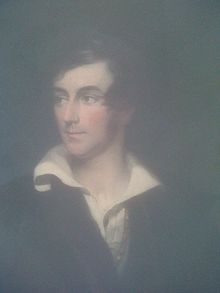
Frederick Hervey-Bathurst
Sir Frederick Hervey-Bathurst 3rd Baronet was a famous English cricketer. Hervey-Bathurst was a right-handed batsman who bowled right-RM roundarm fast.
Hervey-Bathurst made his first-class debut in 1831 for the Bs against an early England side.
He made his debut for the Marylebone Cricket Club against the Cambridge Town Club. Hervey-Bathurst would represent the MCC in 28 first-class matches up until 1855. In his 28 matches for the club, he scored 306 runs at a batting average of 7.46 and with a high score of 34. With the ball he took 63 wickets at a bowling average of 12.00, with best figures of in an innings of 6/?.
In 1842, he made his debut for pre-county club Hampshire against the Marylebone Cricket Club. Hervey-Bathurst represented Hampshire in 12 first-class matches between 1842 and 1861. In his 12 matches, he scored 203 runs at an average of 9.22 and a high score of 46. With the ball he took 72 wickets at an average of 14.23, with a best return of 7 wickets in an innings, although his exact best figures are unknown.
Hervey-Bathurst was one of three local gentlemen, Thomas Chamberlayne and Sir John Barker-Mill, who financed the development of the Antelope Ground and installed the former Hampshire and Surrey cricketer Daniel Day in the Antelope Hotel.
As well as representing the above major sides, he also represented the Gentlemen in 20 Gentlemen v Players fixtures, where he took 73 wickets at an average of 11.25, with best figures of 7/?. He also represented the Gentlemen of England in 12 first-class matches, where he took 88 wickets at an average of 19.40, with a best return of 6 wickets in an innings. Hervey-Bathurst also represented A to K, England, the Gentlemen of Marylebone Cricket Club, the Gentlemen of the South, the South of England and the West of England.
In his overall first-class career he played 92 matches, scoring 817 runs at an average of 9.92, with a high score of 46. With the ball he took 349 wickets at an average of 13.02, with 32 five wicket hauls, 8 ten wicket hauls in a match and a best return of 7 wickets in an innings, although his exact figures are unknown.
Hervey-Bathurst died at Clarendon Park, Wiltshire on 19 October 1881.
Hervey-Bathurst was the start of a cricketing family. He was the father of Frederick Hervey-Bathurst, 4th Baronet who represented both the MCC and the pre-county club Hampshire team as well as Hampshire County Cricket Club. His other son, Lionel Hervey-Bathurst represented Hampshire in two first-class matches in 1875. His great-grandson Hervey Tudway played one first-class match for Somerset in 1910 and would go on to fight in the First World War where he was to be killed in action in 1914.


1st book in the Masqueraders Chocolate House series
I and five others have released the first in what could turn out to be a few, an anthology centered around Bath of the Georgian and Regency period. All proceeds go to charity, specifically the Great Ormond Street Hospital.
The Chocolate House
All For Love

Our Authors are noted and award winning storytellers in the genre of Georgian and Regency era Historical Novels:
David W Wilkin
Francine Howarth
Giselle Marks
Jessica Schira
Susan Ruth
Elizabeth Bailey
A Sensual blend of Chocolate, Romance, Murder & Mystery at “Masqueraders”.
The beautiful City of Bath, famous for its Roman Spa, its Abbey, its Pump Room & Assembly Rooms, and Sally Lunn’s bun shop, is a place made famous within the literary world by the likes of Jane Austen, Georgette Heyer, and other authors of Georgian and Regency historical novels. Thus Bath is renowned as a place for intrigue and romance, but few readers will have stepped across the threshold of Masqueraders’, a notorious and fashionable Chocolate House, that existed within the city from 1700 to the latter part of the reign of William IV. What happened to it thereafter, no one knows, for sure. Nor does anyone know why Sally Lunn’s bun shop disappeared for decades until it was rediscovered.
So it could be said, essence of chocolate drifting on the ether denotes where the seemingly mystical Masqueraders’ once existed, and it is that spiritual essence that has brought authors together from around the globe, to pen a delightful collection of Georgian & Regency romances, that are, all, in some way, linked to The Chocolate House. We sincerely hope you will enjoy the individual stories, and be assured all the royalties earned will be donated to Great Ormond Street Hospital for Children, London.
The stories:
A Rose by Any Other – Giselle Marks.
A Fatal Connection – Elizabeth Bailey
The Runaway Duchess – Francine Howarth
Death at the Chocolate House – Susan Ruth
A-Pig-in-a-Poke – Jessica Schira
A Little Chocolate in the Morning – David W. Wilkin.
My story (As the author and owner of this Blog, I feel I can tell you more) is the story of Charles Watkins the Marquis of Rockford (for those who want the nitty gritty, ask and we can discuss the very specific creation of name details that went into this) who has recently come into his title and estates, his father dying just about a year before. Now he is to return to London after his mourning is over to use his seat in the House of Lords in aid of the war against Napoleon. He is not in Town to seek a bride though the dowager Marchioness should like that he attain one.
No, certainly not the schoolmate of his younger sister Emma, Lady Caroline Williamson, the daughter of the Earl of Feversham. A girl as young and silly as his sister, he would never wed, and certainly not fall in love with. But rescuing her from the clutches of a man who was old enough to be his own grandfather, that he could do with ease, and perhaps Panache.
Available at Amazon Digitally for your Kindle for $2.99 or Physically in Trade Paperback


December 28, 2016
Regency Personalities Series-Nathaniel Wallich
Regency Personalities Series
In my attempts to provide us with the details of the Regency (I include those who were born before 1811 and who died after 1795), today I continue with one of the many period notables.
Nathaniel Wallich
28 January 1786 – 28 April 1854
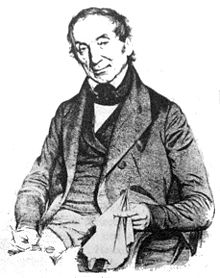
Nathaniel Wallich
Nathaniel Wallich was born in Copenhagen in 1786 as Nathan Wulff Wallich. His father Købmand Wulff Lazarus Wallich (1756–1843) was a Jewish merchant who settled in Copenhagen and came from the Holsatian town Altona near Hamburg late in the 18th century. His mother was Hanne née Jacobson (1757–1839). Wallich obtained the diploma of the Royal Academy of Surgeons at Copenhagen and at the end of the year was appointed as Surgeon in the Danish settlement at Serampore, then known as Frederiksnagore in Bengal.
Wallich sailed for India in April 1807 via the African cape and arrived at Serampore the following November. He was an honorary doctor at the University of Copenhagen and member of the Royal Danish Academy of Sciences and Letters. However, the Danish alliance with Napoleonic France resulted in many Danish colonies being seized by the British, including the outpost at Frederiksnagore. When the British East India Company took over Frederiksnagore, Wallich was imprisoned, but released on parole in 1809 on the merit of his scholarship.
From August 1814, Wallich became an Assistant Surgeon in the East India Company’s service and resigned as Superintendent of the Indian Museum in December 1814. Wallich received an M.D. from Aberdeen in 1819. Wallich was later appointed assistant to William Roxburgh, the East India Company’s botanist in Calcutta. By 1813 he had become interested in the flora of India, and undertook expeditions to Nepal, West Hindustan, and lower Burma. During 1837 and 1838, Nathaniel Wallich served as Professor of Botany at Calcutta Medical College.
Wallich proposed the forming of a museum in a letter dated 2 February 1814 to the Council of the Asiatic Society. Wallich offered his services to the Society and some items from his own collections for the Museum. The Society heartily supported the proposal and resolved to set up a museum and to appoint Wallich to be the Honorary Curator and then Superintendent of the Oriental Museum of the Asiatic Society. Dr. Nathaniel Wallich took charge of the Museum on 1 June 1814. The Museum thus inaugurated, grew rapidly under the guidance of its founder Wallich and private collectors. Most of these private contributors were Europeans except for one Indian, Babu Ramkamal Sen, initially a collector and later the first Indian Secretary to the Asiatic Society. Wallich was not only the enthusiastic founder and the first Curator the Indian Museum, he was one of the largest donors to the Museum at its inception. Out of one hundred seventy four items donated to the Museum till 1816, Wallich donated forty-two botanical specimens.
Wallich was also temporarily appointed Superintendent of East India Company’s Botanical Garden at Calcutta and later permanently joined the Garden in 1817 and served there till 1846 when he retired from the service. Ill health forced Wallich to spend the years 1811-1813 in the more temperate climate of Mauritius, whence he continued his studies. In 1822, at the behest of his friend Sir Stamford Raffles he travelled to Singapore to design the botanical garden, but returned to Calcutta the following year.
Wallich prepared a catalogue of more than 20,000 specimens, known informally as the “Wallich Catalogue”. The specimens in the catalogue were either collected by Wallich himself or from other collectors around the same period, including Roxburgh, Gomez, Griffith and Wight. The collector of each specimen is clearly cited in the catalogue itself. Today, Wallich’s personal collection is housed at the Kew Herbarium as the Wallich Collection. In addition to the specimens there, Wallich also distributed duplicates of his specimens to herbaria, including some to Sir Joseph Banks, which are in the Kew general collection. He published two important books, Tentamen Florae Nepalensis Illustratae (vols I-II, 1824–26) and Plantae Asiaticae Rariores (vols I-III, 1830–32), and went on numerous expeditions. One of Wallich’s greatest contributions to the field of plant exploration was the assistance he regularly offered to the many plant hunters who stopped in Calcutta on their way to the Himalayas.
The three volumes of Plantae Asiaticae rariores made use of artists employed by the Calcutta Botanic Garden: 146 drawings by Gorachand, 109 by Vishnupersaud and one work by Rungiah (the artist employed by Robert Wight); the rest of the plates were by John Clark and three by William Griffith. 250 copies of the work were printed, of which 40 were purchased by the East India Company.
Wallich had suffered deteriorating health for many years, at one time contracting cholera, and he was finally obliged to resign his post in 1846 and retire to London, where he became Vice-President of the Linnean Society, of which he had been a fellow since 1818. Wallich remained in London until his death seven years later aged 68; he was buried in Kensal Green Cemetery.
Part of Wallich’s herbarium collections held at Kew, and known as the ‘Wallich Herbarium’, is the largest separate herbarium. Another part of the collection is the Central National Herbarium of the Botanical Survey of India in Calcutta, making in all about 20,500 specimens. Wallich is also credited with the authorship of 35 papers, mostly botanical.
Wallich married Juliane Marie Hals (b.1797), later known as Mary Ann, on 30 May 1812, but she died only two months later. In 1815, Wallich married Sophia Collings (1797–1876), who bore him seven children, two of whom died in infancy. Their eldest son George Charles became a distinguished oceanographer.


An Unofficial Guide to how to win the Scenarios of Rollercoaster Tycoon 3 Soaked and Wild
An Unofficial Guide to how to win the Scenarios of Rollercoaster Tycoon 3, Soaked! and WILD!
I have been a fan of this series of computer games since early in its release of the very first game. That game was done by one programmer, Chris Sawyer, and it was the first I recall of an internet hit. Websites were put up in dedication to this game where people showed off their creations, based on real amusement parks. These sites were funded by individuals, an expense that was not necessarily as cheap then as it is now. Nor as easy to program then as it might be to build a web page now.
Prima Books released game guides for each iteration of the game, Rollercoaster Tycoon 1, Rollercoaster Tycoon 2 and Rollercoaster Tycoon 3 (RCT3) but not for the expansion sets. And unlike the first two works, the third guide was riddled with incorrect solutions. As I played the game that frustrated me. And I took to the forums that Atari, the game publisher hosted to see if I could find a way to solve those scenarios that the Prima Guide had written up in error. Not finding any good advice, I created my own for the scenarios that the “Official” Guide had gotten wrong.
Solutions that if you followed my advice you would win the scenario and move on. But if you followed the
“Official” version you would fail and not be able to complete the game. My style and format being different than the folks at Prima, I continued for all the Scenarios that they had gotten right as well, though my solutions cut to the chase and got you to the winner’s circle more quickly, more directly.
My contributions to the “Official” Forum, got me a place as a playtester for both expansions to the game, Soaked and Wild. And for each of these games, I wrote the guides during the play testing phase so all the play testers could solve the scenarios, and then once again after the official release to make changes in the formula in case our aiding to perfect the game had changed matters. For this, Atari and Frontier (the actual programmers of the game) placed me within the game itself.
And for the longest time, these have been free at the “Official” Forums, as well as my own website dedicated to the game. But a short time ago, I noticed that Atari, after one of its bankruptcies had deleted their forums. So now I am releasing the Guide for one and all. I have added new material and it is over 150 pages, for all three games. It is available for the Kindle at present for $7.99. It is also available as a trade paperback for just a little bit more.
You can also find this at Smashwords, iBooks, Kobo and Barnes and Noble
(Click on the picture to purchase)
Not only are all 39 Scenarios covered, but there are sections covering every Cheat Code, Custom Scenery, the famous Small Park Competition, the Advanced Fireworks Editor, the Flying Camera Route Editor which are all the techniques every amusement park designer needs to make a fantastic park in Rollercoaster Tycoon 3.
Scenarios for RCT 3
1) Vanilla Hills
2) Goldrush
3) Checkered Flag
4) Box Office
5) Fright Night
6) Go With The Flow
7) Broom Lake
8) Valley of Kings
9) Gunslinger
10) Ghost Town
11) National Treasure
12) New Blood
13) Island Hopping
14) Cosmic Crags
15) La La Land
16) Mountain Rescue
17) The Money Pit
18) Paradise Island
Scenarios for Soaked!
1) Captain Blackheart’s Cove
2) Oasis of Fun
3) Lost Atlantis
4) Monster Lake
5) Fountain of Youth
6) World of the Sea
7) Treasure Island
8) Mountain Spring
9) Castaway Getaway
Scenarios for WILD!
1) Scrub Gardens
2) Ostrich Farms Plains
3) Egyptian Sand Dance
4) A Rollercoaster Odyssey
5) Zoo Rescue
6) Mine Mountain
7) Insect World
8) Rocky Coasters
9) Lost Land of the Dinosaurs
10) Tiger Forest
11) Raiders of the Lost Coaster
12) Saxon Farms


December 27, 2016
Regency Personalities Series-George Baillie Hamilton 10th Earl of Haddington
Regency Personalities Series
In my attempts to provide us with the details of the Regency (I include those who were born before 1811 and who died after 1795), today I continue with one of the many period notables.
George Baillie Hamilton 10th Earl of Haddington
14 April 1802 – 25 June 1870
George Baillie Hamilton 10th Earl of Haddington was the son of George Baillie and his wife Mary (née Pringle). Charles Baillie, Lord Jerviswoode, was his younger brother.
He succeeded his second cousin Thomas Hamilton, 9th Earl of Haddington in the earldom in 1858, and in 1859 he assumed by Royal licence the additional surname of Hamilton.
The latter year he was also elected a Scottish Representative Peer and took his seat on the Conservative benches in the House of Lords. He served under the Earl of Derby and Benjamin Disraeli as a Lord-in-Waiting (government whip in the House of Lords) from 1867 to 1868. Between 1867 and 1868 he was also Lord High Commissioner to the General Assembly of the Church of Scotland.
Lord Haddington died at Tyninghame House on 25 June 1870, aged 68.
Lord Haddington married Georgina Markham (d. 26 February 1873), daughter of the Venerable Robert Markham, Archdeacon of York, on 16 December 1824 and had issue:
George Baillie-Hamilton-Arden, 11th Earl of Haddington
Hon Robert Baillie-Hamilton (1828-1891) MP for Berwickshire
Hon. Clifton Baillie-Hamilton (1831-1857)
Cdr. the Hon. Henry Baillie-Hamilton
Hon. Percy Baillie-Hamilton died in infancy
Rev the Hon. Arthur Baillie-Hamilton, vicar of Badley
Lady Mary Baillie-Hamilton
Lady Frances Baillie-Hamilton
Lady Georgina Baillie-Hamilton



